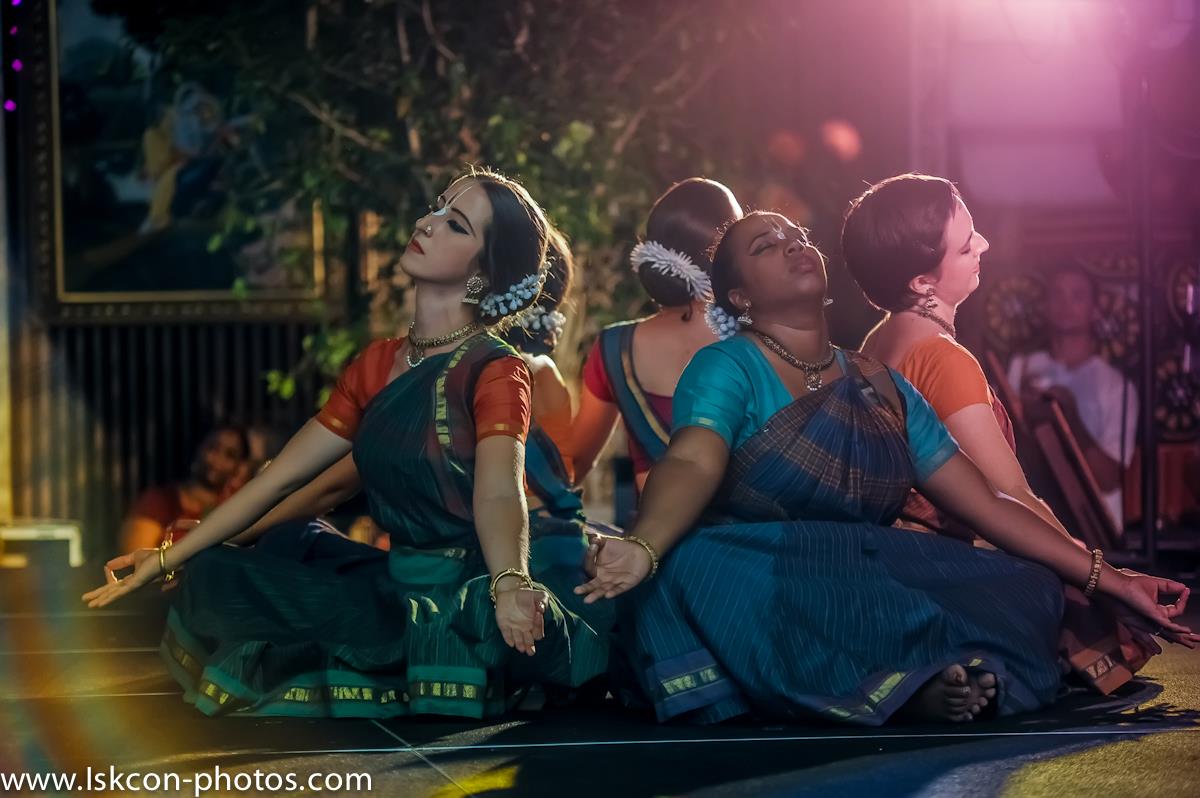Bhakti Dance Troupe Blends Yoga and Bharat Natyam
By Madhava Smullen | Jun 23, 2012

Photos by Ananta Vrindavan Das
The Bhakti Dance Troupe, a traditional Bharat-Natyam ensemble from the ISKCON community in Alachua, Florida, have blended Bharat Natyam with yoga to create an enthralling new kind of performance.
Choreographer Anapayini Dasi, who began studying Bharat Natyam at the age of five and now runs Alachua’s Bhakti-Kalalayam Dance Academy, says she got the idea while driving.
“I had been studying yoga too, and began noticing its symmetrical similarity with Bharat Natyam,” she explains. “I’m not into fusion just for the sake of it, but as both were sacred movements and really complimented each other, I felt that combining them would be a bona fide eandeavor. Then one day this January, I was driving while listening to the track Narayana by Chakrini, a devotee I grew up with. It was so powerful it made me dance while driving, and I thought: This is it! This is the music to show yoga and Bharat Natyam together!”
With her Bhakti Dance Troupe, consisting of seven other second generation devotees in their early twenties, Anapayini proceeded to choreograph a new routine blending the two.
“It was much easier than choreographing a new Bharat Natyam dance, which is far more technical and involves memorizing intricate footwork,” she says. “On top of that, a new Bharat Natyam Dance is a big ordeal because I have to go to India to record new traditional Carnatic music for it. But with the yoga dance, we have ready-made music, and I can just run with it.”

Laksmi Narayana emerge from an unfurling lotus flower
The Bhakti Dance Troupe’s first performance of the new dance was at the Miami Rathayatra festival on March 17th, while subsequent performances followed at Festival of Inspiration in New Vrindaban, West Virginia; New Panihati Dhama, Atlanta; New York Rathayatra and St. Augustine Rathayatra.
Anapayini and her troupe will continue to perform the dance on the Krishna Culture Youth Bus Tour across North America and Canada this summer, appearing at both Rathayatra festivals and theatrical venues.
At each venue, the Bhakti Dance Troupe will perform four dances, opening with a Bharat-Natyam piece with a difference. Choreographed not to Carnatic music but to Invoking the Ancients by second generation kirtan group the Mayapuris, the piece depicts the darkest aspects of the modern age known as Kali Yuga, including animal slaughter, alcoholism, gambling, promiscuity, hunger and war. It concludes with the great saint Advaita Acharya praying to Lord Krishna to appear and save the world.
“If you want to see a machine gun depicted in a Bharat Natyam performance, catch our show,” jokes Anapayini.
The Bhakti Dance Troupe’s third and fourth dances will feature full traditional Bharat Natyam dance, with traditional Bharat Natyam dress and ankle bells to match.
But it’s in the second dance of their repertoire that they’ll perform their first—and so far only—blend of yoga and Bharat-Natyam. Often, but not always, this is performed wearing only one piece of traditional attire—the colorful skirt—along with black t-shirts and leggings, for freer movement.

Narayana rides upon his bird carrier Garuda
As the dance is an offering to Lord Narayana, the dancers begin by portraying sages meditating upon Him, using various yoga meditation poses. Flowing from one yoga pose to another in a series called Vinyasa, they bow to the Lord with folded hands.
Next, after showing Garudasana, wherein one arm and one leg is intertwined about the other, they morph into a collective portrayal of Lord Narayana riding upon his bird carrier Garuda, using different yoga poses. Anapayini, as Lord Narayana, rests her leg upon the shoulder of another girl, who is the beak of Garuda. Two others, in the yoga pose of Ardha Chandrasana, bend forward on one leg, raising their back legs and waving their arms as wings, while another girl, at the back, portrays Garuda’s tail.
Throughout the piece, the dancers come together as one many more times to depict other similar stunning images: Lord Narayana rests upon the divine serpent Ananta Sesa in one pose, while Laksmi Narayana appear in the center of an unfurling lotus flower in another.
“That is depicted using Ustrasana, or the camel pose, a yoga backbend,” says Anapayini. “Other yoga poses we use include Surya Namaskara, and Badakonasana, the butterfly.”
Meanwhile, several Bharat Natyam steps are incorporated, and Bharat-Natyam mudras, or hand signs, are used to show Lord Narayana’s conchshell, disc, lotus and club as well as other items.

Lord Narayana reclines on the divine serpent Ananta Sesa
“The piece ends as it began, with the sages praying to the Lord, as if what came before was a vision they had,” Anapayini says. “With the gentle guitar and tablas of Chakrini’s song, it is very meditative. The dance doesn’t have any literal meaning; rather, my intention is for the audience to feel deep feelings of awe and reverance at the beauty of Lord Narayana.”
This blend of yoga and Bharat-Natyam has been a hit with Western audiences, who are less educated in the technical steps of classical Indian dance.
It’s also exciting for Anapayini, for whom the soft, fluid movements of yoga present something new to add along with the staccato rhythms of Bharat-Natyam.
“In addition, the Gaudiya Vaishnava music, as well as being made by my friends, is the music I grew up worshipping the Lord with,” Anapayini says. “And therefore it moves me in a much deeper, sweeter way than traditional Carnatic music does.”
In the future, Anapayini hopes to continue presenting her unique style of combined Bharat Natyam and yoga as half of her repertoire, along with her more traditional Bharat Natyam performances.
“The girls bring such deep meaning to the songs, dance so elegantly, and are dressed so beautifully, that it really attracts people to Krishna consciousness,” Anapayini says. “And I think that’s what ISKCON’s founder Srila Prabhupada meant when he called for a cultural conquest.”












